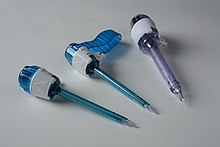Trocar


Atrocar(ortrochar) is amedicalorveterinarydevice used inminimally invasive surgery.Trocars are typically made up of anawl(which may be metal or plastic with a pointed or tapered tip), acannula(essentially a rigid hollow tube) and often aseal.[1][2]Some trocars also include avalvemechanism to allow forinsufflation.Trocars are designed for placement through thechestandabdominal wallsduringthoracoscopicandlaparoscopicsurgery,and each trocar functions as aportalfor the subsequent insertion of otherendoscopicinstruments such asgrasper,scissors,stapler,electrocautery,suctiontip, etc. — hence the more commonly used colloquial jargon "port".Trocars also allow passive evacuation of excess gas or fluid from organs within the body.
Etymology[edit]
The wordtrocar,less commonlytrochar,[3]comes fromFrenchtrocartortrocar,itself either fromtrois-quarts'three fourths' or fromtrois carres'three sides';[4][5][6]in any case referring to the instrument's triangular point. First recorded in theDictionnaire des Arts et des Sciences,1694,[7]byThomas Corneille,younger brother ofPierre Corneille.
History[edit]

Originally, doctors used trocars to relieve pressure build-up of fluids (edema) or gases (bloating). Patents for trocars appeared early in the 19th century, although their use dated back possibly thousands of years. By the middle of the 19th century, trocar-cannulas had become sophisticated, such asReginald Southey's invention of the Southey tube.[8]
Applications[edit]
Medical/surgical use[edit]
Trocars are used in medicine to access and drain collections of fluid such as in a patient withhydrothoraxorascites.
In modern times, surgical trocars are used to performlaparoscopicsurgery. They are deployed as a means of introduction for cameras and laparoscopic hand instruments, such as scissors, graspers, etc., to perform surgery hitherto carried out by making a large abdominal incision, something that has revolutionized patient care. Today, surgical trocars are most commonly a single patient use instrument and have graduated from the "three-point" design that gave them their name to either a flat bladed "dilating-tip" product or something that is entirely blade free. This latter design offers greater patient safety due to the technique used to insert them.
Trocar insertion can lead to a perforating puncture wound of an underlying organ resulting in amedical complication.Thus, for instance, a laparoscopic intra-abdominal trocar insertion can lead to bowel injury leading to peritonitis or injury to large blood vessels with hemorrhage.[9]
Embalming[edit]
Trocars are also used near the end of theembalmingprocess to provide drainage of bodily fluids and organs after the vascular replacement of blood with embalming chemicals. Rather than a round tube being inserted, the three-sided knife of the classic trocar would split the outer skin into three "wings" which was then easily sutured closed. In a less obtrusive way, a trocar button can be used in place of a suture. It is attached to a suction hose, usually attached to awater aspirator,but an electric aspirator can also be used. The process of removing gas, fluids, and semi-solids from the body cavities and hollow organs using the trocar is known as aspiration. The instrument is inserted into the body two inches to the (anatomical) left and two inches up from the navel. After thethoracic,abdominal,andpelviccavities have been aspirated, the embalmer injects cavity fluid into the thoracic, abdominal and pelvic cavities, usually using a smaller trocar attached via a hose connected to a bottle of high-index cavity fluid. The bottle is held upside down in the air so as to let gravity take the cavity fluid through the trocar and into the cavities. There is a small thumb hole attached to the fluid injector to control the flow of liquid. The embalmer moves the trocar in the same manner used when aspirating the cavities. In order to fully and evenly distribute the chemical, it is recommended to use 1 bottle of cavity fluid for the thoracic cavity and 1 for the abdominal cavity.
After cavity embalming has been finished, the puncture is commonly sealed using a small plastic object resembling a screw, called a trocar button.
Veterinary use[edit]
Trocars are widely used by veterinarians not only for draining hydrothorax, ascites, or for introducing instruments in laparoscopic surgery, but for acute animal-specific conditions as well. In cases ofruminal tympanyin cattle, a wide-bore trocar may be passed through the skin into therumento release trapped gas.[10]In dogs, a similar procedure is often performed for patients presenting withgastric dilatation volvulusin which a wide-bore trocar is passed through the skin into the stomach to immediately decompress the stomach. Depending on the severity of clinical signs on presentation, this is often performed after pain management has been administered but prior togeneral anaesthesia.Definitive surgical treatment involves anatomical repositioning of the stomach and spleen followed by a right-sidedgastropexy.[11]Depending on the severity, partialgastrectomyand/orsplenectomymay be indicated if the relevant tissues have necrosed due to ischemia caused by torsion/avulsion of the supplying vasculature.
In popular culture[edit]
In the movieFar from the Madding Crowd(1967) Gabriel Oak, played byAlan Bates,uses a trocar to aspirate abdominal gasses from Bathsheba Everdene's herd of sheep who had strayed into a field ofcloverand were bloated.
In the movieTrue Lies,Arnold Schwarzenegger's character, having picked the lock on his handcuffs, uses a Patterson trocar to kill his guard prior to breaking the neck of his torturer.
Citations[edit]
- ^Equipment and instrumentation for Laparoscopic bariatric surgeryin Cleveland Clinic
- ^Alph Degive, Précis de médicine opératoire vétérinaire, Asselin & Houzeau, 1908, p. 139
- ^"trocar".Merriam-Webster Dictionary.Merriam-Webster.RetrievedDecember 6,2018.
- ^"trocar".Oxford Dictionaries.Oxford University Press. Archived fromthe originalon December 6, 2018.RetrievedDecember 6,2018.
- ^Kucklick, Theodore R. (2013).The Medical Device R&D Handbook(2 ed.). Boca Raton, FL: CRC Press, Taylor & Francis Group. p. 109.ISBN978-1-4398-1189-4.RetrievedDecember 6,2018.
- ^Diderot, Denis (1751).L'Encyclopédie.
- ^"Dictionnaire des Arts et des Sciences - Wikisource".fr.wikisource.org.
- ^Library, Boston Medical (20 February 2018)."Boston Medical Library".countway.harvard.edu.
- ^S. Krishnakumar; P. Taube (2009)."Entry Complications in Laparoscopic Surgery".J Gynecol Endosc Surg.1(1): 4–11.doi:10.4103/0974-1216.51902(inactive 2024-04-24).PMC3304260.PMID22442503.
{{cite journal}}:CS1 maint: DOI inactive as of April 2024 (link) - ^Constable, PD; Hinchcliff, KW; Done, SH; Gruenberg, W (2016). "Chapter 8: Diseases of the alimentary tract - ruminants. Ruminal tympany (bloat)".Veterinary Medicine: A textbook of the diseases of cattle, horses, sheep, pigs and goats(11 ed.). Elsevier Health Sciences. pp. 473–482.ISBN978-0-7020-7058-7.
- ^Bright, Ronald M. (June 2007)."Acute Gastric Dilatation-Volvulus in Dogs"(PDF).Clinician's Brief.Archived fromthe original(PDF)on 2018-02-19.Retrieved2017-08-04.
General and cited references[edit]
- Janet Amundson Romich.An illustrated guide to veterinary medical terminology, Volume 1
- Mayer, Robert (2006).Embalming: History, Theory, and Practice(4th ed.). McGraw-Hill.ISBN0-07-143950-1.
